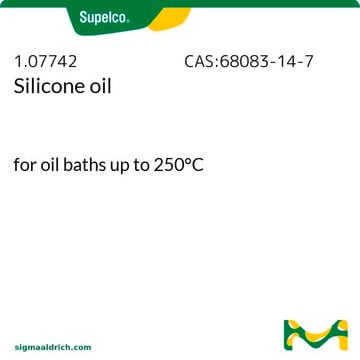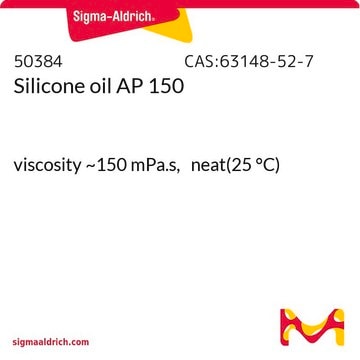The silicon oil products are not tested for melting point range. The product SDS reports the melting point based on the published physical properties of materials that fall under a given CAS number. Products under CAS# 63148-62-9 report a melting point of -55°C. The CAS# 9016-00-6, Polydimethylsiloxane. lists a melting point of -50°C.
146153
Silicone oil
for melting point and boiling point apparatuses
Seleccione un Tamaño
86,10 €
Seleccione un Tamaño
About This Item
86,10 €
Productos recomendados
densidad de vapor
>1 (vs air)
presión de vapor
<5 mmHg ( 25 °C)
5 mmHg ( 20 °C)
tpo
for melting point and boiling point apparatuses
Parámetros
−40-350 °F temp. range (−40-175 °C)
índice de refracción
n20/D 1.403 (lit.)
viscosidad
45.0-55.0(25 °C)
bp
>140 °C/0.002 mmHg (lit.)
densidad
0.963 g/mL at 25 °C
¿Está buscando productos similares? Visita Guía de comparación de productos
Aplicación
- for melting-point and boiling-point apparatus
- in membrane contactors to impregnate fibers
- on rheometer samples (chicken skin and bovine gelatin) to prevent evaporation during heating using temperature sweeps and frequency sweeps
Acciones bioquímicas o fisiológicas
Características y beneficios
- High viscosity
- Low water solubility
- Low vapor pressure
Código de clase de almacenamiento
10 - Combustible liquids
Clase de riesgo para el agua (WGK)
WGK 1
Punto de inflamabilidad (°F)
214.0 °F - closed cup
Punto de inflamabilidad (°C)
101.1 °C - closed cup
Equipo de protección personal
Eyeshields, Gloves
Elija entre una de las versiones más recientes:
Certificados de análisis (COA)
¿No ve la versión correcta?
Si necesita una versión concreta, puede buscar un certificado específico por el número de lote.
¿Ya tiene este producto?
Encuentre la documentación para los productos que ha comprado recientemente en la Biblioteca de documentos.
Los clientes también vieron
-
What is the part number of silicon oil that has a melting point at around - 50C.
1 respuesta-
¿Le ha resultado útil?
-
Filtros activos
Nuestro equipo de científicos tiene experiencia en todas las áreas de investigación: Ciencias de la vida, Ciencia de los materiales, Síntesis química, Cromatografía, Analítica y muchas otras.
Póngase en contacto con el Servicio técnico






